As an Amazon Associate KitchenwareSets.com earns from qualifying purchases.
How To Organize Kitchen Cabinets With 11 Genius Space Saving Tricks
Does opening your kitchen cabinets feel like entering a battle zone? You’re not alone. The daily struggle of searching for a matching lid, navigating an avalanche of baking sheets, or finding that one specific spice can turn the heart of your home into a source of constant, low-grade stress. It’s that feeling of chaos that makes cooking feel like a chore rather than a joy.
This clutter isn’t just messy; it’s inefficient. It wastes your time, your money (when you buy duplicate items you couldn’t find), and your peace of mind. You know there must be a better way, a system that brings calm and order, but the sheer scale of the project can feel completely overwhelming. Where do you even begin when every cabinet and drawer seems to be a problem area?
The key to organizing your kitchen cabinets is to first declutter everything you don’t need, then create logical “zones” for what remains, and finally implement smart storage solutions to maximize every inch of space. This systematic approach transforms the daunting task into a series of manageable steps, leading to a functional, stress-free kitchen that works for you, not against you.
Overwhelmed by Kitchen Chaos? Here’s How to Systematically Organize Your Cabinets
The first step to organizing kitchen cabinets is to completely empty them. This foundational step prevents you from simply rearranging clutter. It allows you to take a full inventory, deep clean the empty space, and thoughtfully assess what you truly need before putting anything back in its new, logical home. This process is about creating a functional system, not just a temporarily tidy appearance. I’ve found that this fresh start is the only way to truly break old habits and build a new, efficient daily routine.
We can break down this overwhelming project into a proven, 4-step system used by professional organizers: Declutter, Zone, Implement, and Maintain. Following this strategy turns chaos into calm.
Step 1: The Great Kitchen Cabinet Cleanout (Declutter & Inventory)
To declutter kitchen cabinets, sort all items into three categories: Keep, Donate/Sell, and Discard. This simple method forces you to make a decision about every single item, ensuring only useful things return to your clean, organized cupboards.
- Empty Everything: Take every single item out of your cabinets and drawers. Place them on your counters, dining table, or the floor. This is the only way to see the full scope of what you own.
- Sort and Purge: Create your three piles. Be ruthless.
- Keep: Items you use regularly and love.
- Donate/Sell: Good-condition items you no longer need, like duplicate utensils, that extra set of mugs, or unused small appliances.
- Discard: Throw away anything broken, chipped, or expired. Check the dates on all your canned goods and spices! A common professional organizer’s guideline is the “one-year rule”—if you haven’t used it in the last year, it’s time for it to go.
- Relocate Non-Kitchen Items: Find the random batteries, mail, and tools a new home elsewhere in the house.
- Clean Thoroughly: With the cabinets and drawers completely empty, give them a deep clean. Wipe down all surfaces, vacuum out crumbs, and install fresh shelf liners if you wish.
Step 2: Create a Kitchen ‘Map’ by Defining Your Zones
To create a kitchen map, group similar items together and store them near where they are used most often. This ergonomic approach creates a natural workflow, minimizes unnecessary steps while you’re cooking or cleaning, and makes your kitchen feel more intuitive.
- Dishware Zone: This is for your everyday plates, bowls, and glasses. The best location is in a cabinet right next to or above your dishwasher. This makes unloading a quick and simple task.
- Cooking Zone: Keep pots, pans, baking sheets, and cooking utensils in the cabinets and drawers immediately surrounding your stove and oven. Spices, oils, and vinegars should also live here for easy access while cooking.
- Prep Zone: Store your cutting boards, knives, mixing bowls, and measuring cups near the largest stretch of open counter space. This is your primary area for chopping and food preparation.
- Cleaning Zone: The cabinet under the sink is the natural home for cleaning supplies, dish soap, sponges, and trash bags.
- Storage Zone (Pantry): Designate a cabinet or pantry area for dry goods, canned food, and snacks.
11 Genius Space Saving Tricks To Transform Your Kitchen Cabinets (Updated for 2025)
Once you’ve decluttered and zoned your kitchen, it’s time for the fun part: implementing clever storage solutions. These are the genius tricks that will make your newly organized kitchen truly functional and feel twice as big. We’ve curated these tips from top home organization experts, and I’ve personally tested them in my own kitchen to ensure they are both effective and easy to implement. These hacks will help you find a place for everything, making your cabinets visually appealing and incredibly practical.
1. Double Your Shelf Space with Stackable Shelf Risers
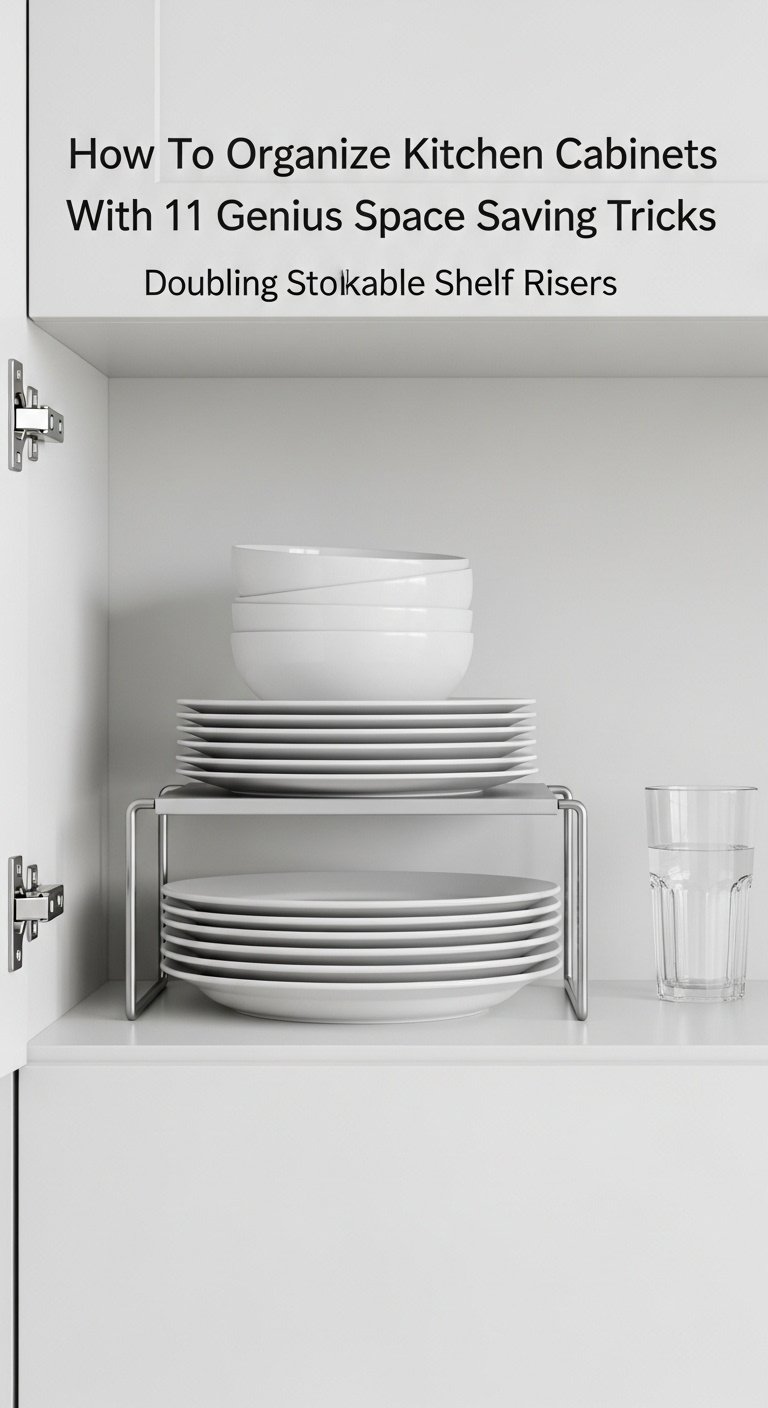
A shelf riser is the fastest way to stop creating precarious, tall stacks of dishes and utilize the empty vertical space in your cabinets.
- Materials Needed: Measuring tape, stackable shelf riser(s).
- Step-by-Step Directions:
- Measure the internal height, width, and depth of your cabinet to ensure a proper fit.
- Purchase shelf risers that match your measurements and aesthetic.
- Place the riser inside the cabinet.
- Stack one type of dish (e.g., large plates or bowls) underneath the riser and another type (e.g., smaller plates or mugs) on top.
Pro-Tip: Look for expandable shelf risers. They can be adjusted to fit the exact width of your cabinet, eliminating wasted space on the sides.
Pin this simple hack to your ‘Kitchen Organization’ board!
2. File Baking Sheets & Cutting Boards with Vertical Dividers
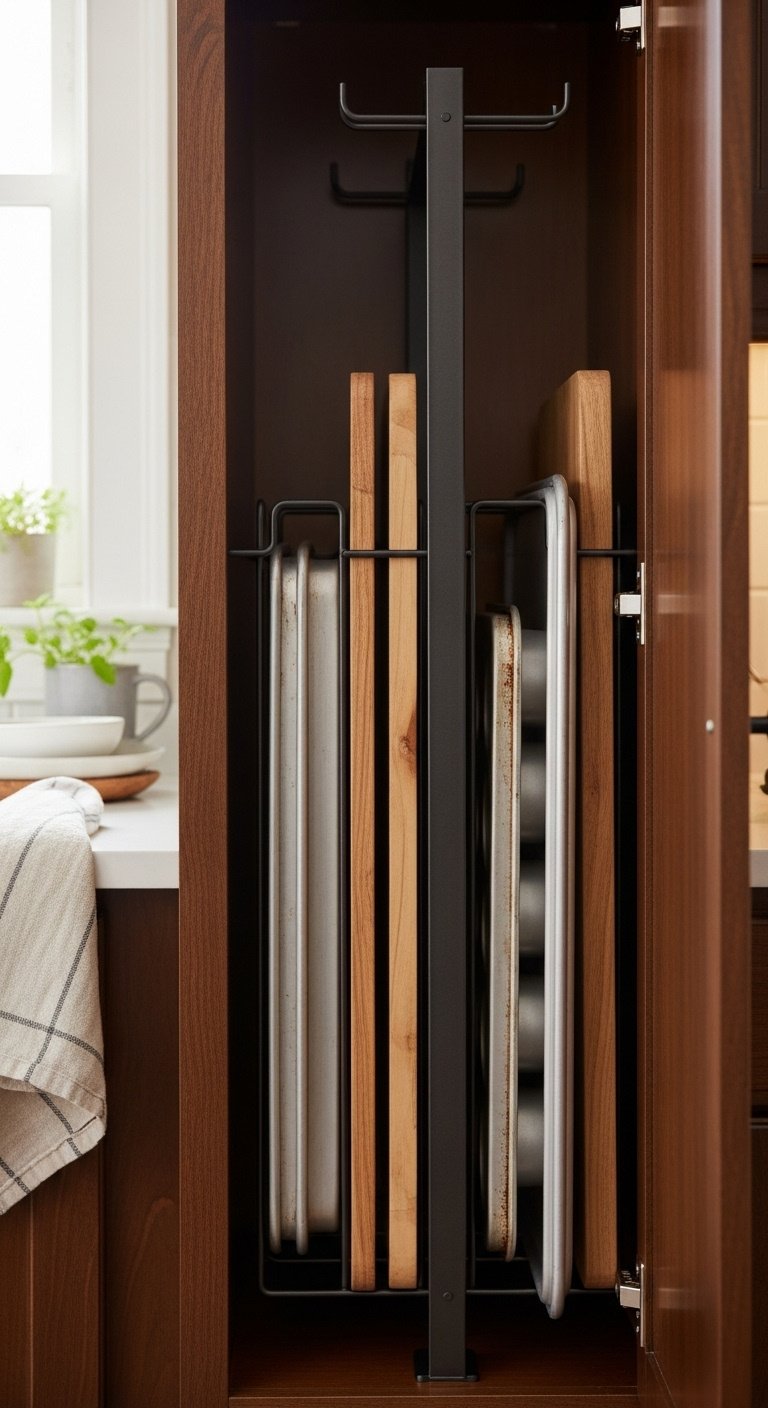
Vertical dividers are a solution for storing flat items like baking sheets and cutting boards so they are easy to grab without causing an avalanche.
- Materials Needed: Vertical pan and lid organizer rack or tension rods, measuring tape.
- Step-by-Step Directions:
- Measure the cabinet where you plan to store your flat items.
- Purchase a freestanding vertical organizer that fits the space. For a DIY solution, buy several tension rods.
- If using an organizer, simply place it in the cabinet.
- If using tension rods, install them vertically, spacing them 2-3 inches apart to create custom slots.
- Slide your baking sheets, cutting boards, and platters into the slots vertically, like files in a filing cabinet.
Lesson Learned: Heavy-duty, coated metal dividers are worth the investment as they prevent scratching on your non-stick bakeware and are sturdy enough to hold cast iron pans.
Love this idea? Save it to your ‘Smart Storage’ Pinterest board!
3. Conquer Corner Cabinets with a Lazy Susan (Turntable)
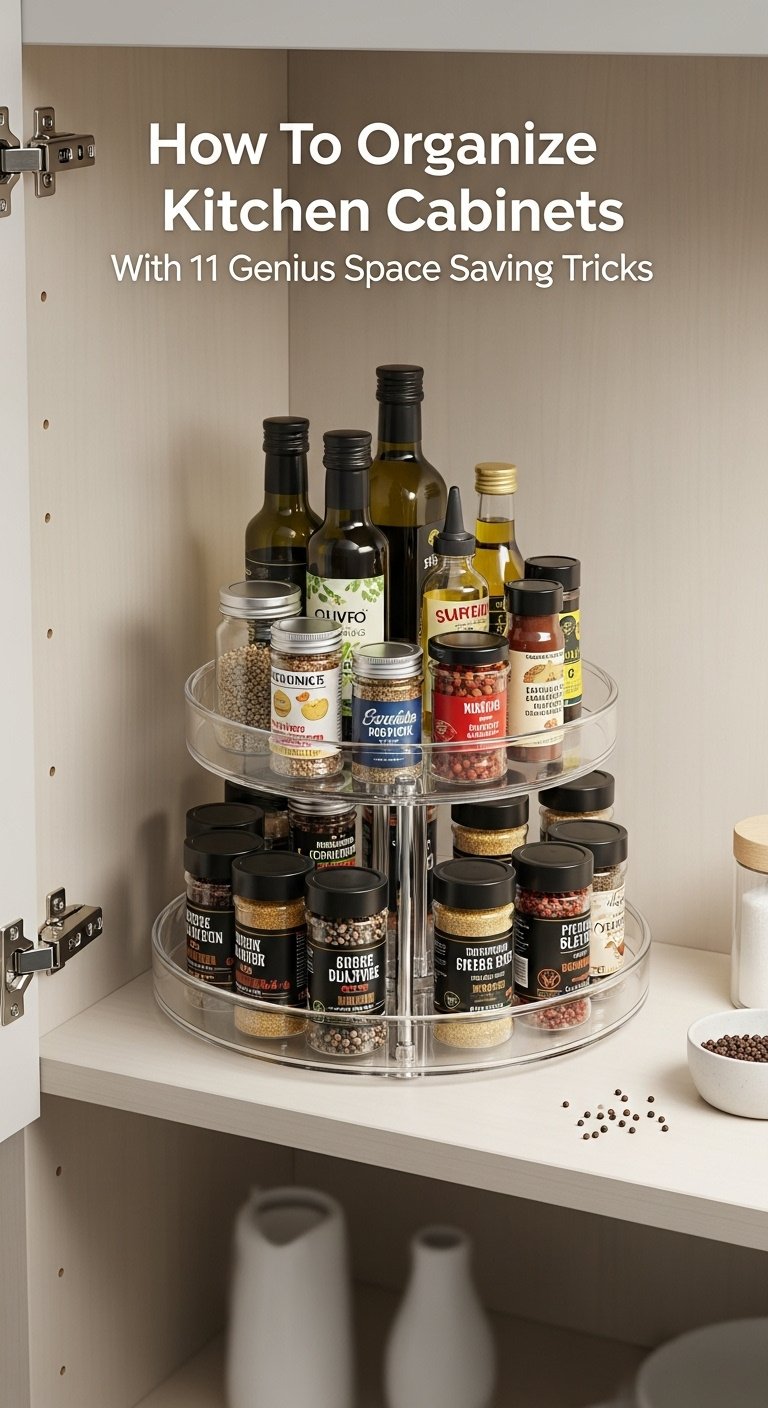
A turntable makes the awkward, hard-to-reach space in a corner cabinet fully accessible and prevents items from getting lost in the back.
- Materials Needed: Measuring tape, lazy susan/turntable.
- Step-by-Step Directions:
- Measure the usable surface area inside your corner cabinet.
- Purchase a turntable that allows for a bit of clearance around the edges so it can spin freely.
- Place the turntable inside the cabinet.
- Arrange items like spices, oils, or canned goods on the turntable. Now you can simply spin it to bring items from the back to the front.
Pro-Tip: Use a turntable with a small lip or rim around the edge. This prevents items from sliding off when you spin it quickly. For spices, a two-tiered turntable can double your storage.
Share this corner cabinet solution with a friend who needs it!
4. Bring the Back of the Cabinet to You with Pull-Out Shelves
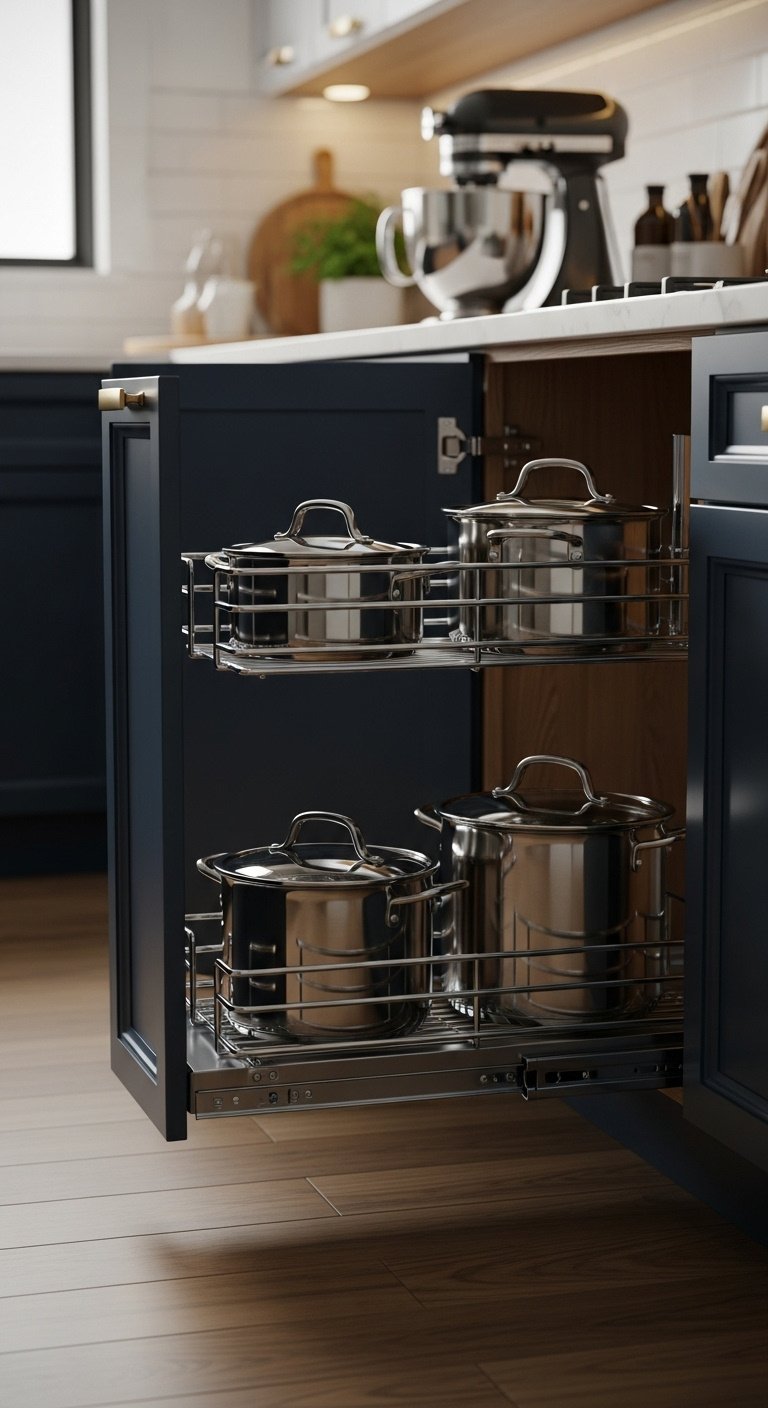
Pull-out shelves solve the problem of deep cabinets where items get lost in the back and are difficult to retrieve, especially heavy pots or small appliances.
- Materials Needed: Pull-out cabinet organizer kit, measuring tape, drill, screwdriver.
- Step-by-Step Directions:
- Carefully measure the interior width, depth, and height of your cabinet, paying close attention to the door hinges.
- Purchase a pull-out shelf kit that matches your dimensions.
- Follow the manufacturer’s instructions to assemble the sliding base.
- Secure the sliding base to the bottom of your cabinet using a drill and the provided screws.
- Attach the basket or shelf to the base and load it with your pots, pans, or small appliances.
Pro-Tip: Invest in full-extension slides. They allow the shelf to pull all the way out of the cabinet, giving you complete access to everything inside without having to reach into the dark.
Pin this deep cabinet solution for your future kitchen remodel!
5. Use Every Inch with Over-the-Door Organizers
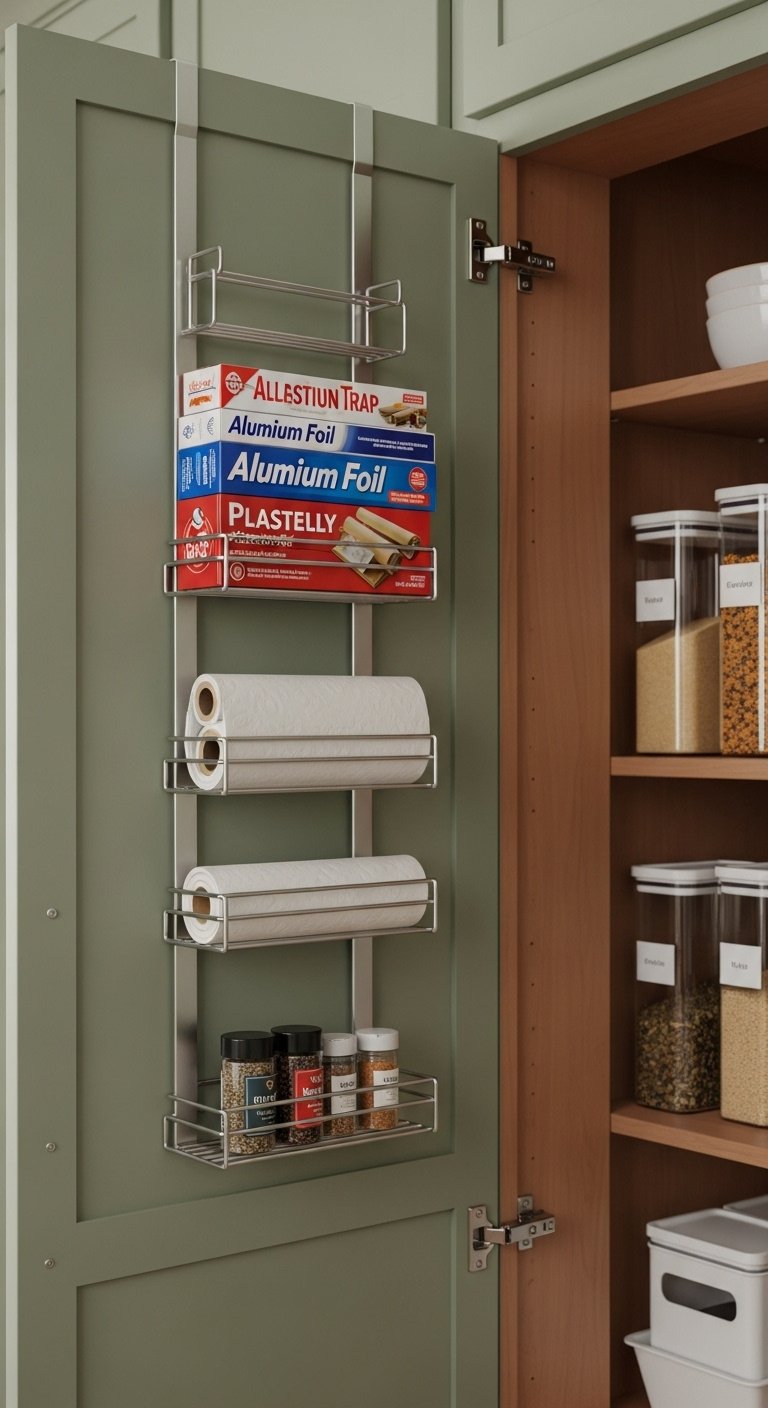
These organizers allow you to utilize the often-ignored storage potential on the inside of cabinet doors for lightweight items.
- Materials Needed: Over-the-door or screw-in door rack, measuring tape, (optional) screwdriver.
- Step-by-Step Directions:
- Measure the inside panel of your cabinet door, ensuring any rack you buy will clear the shelves when the door is closed.
- Choose your organizer: simple hooks for towels, a wire rack for cleaning supplies, or narrow shelves for spices.
- For over-the-door versions, simply hang the organizer over the top of the door.
- For screw-in versions, mark your holes and carefully attach the rack to the inside of the door.
Lesson Learned: Always check your shelf clearance before installing a door rack. Place items on your cabinet shelf and slowly close the door to make sure the new rack doesn’t bump into them. Lightweight items work best here.
Such a clever use of space! Save this to your ‘Small Kitchen Ideas’ board.
6. Divide and Conquer Your Drawers
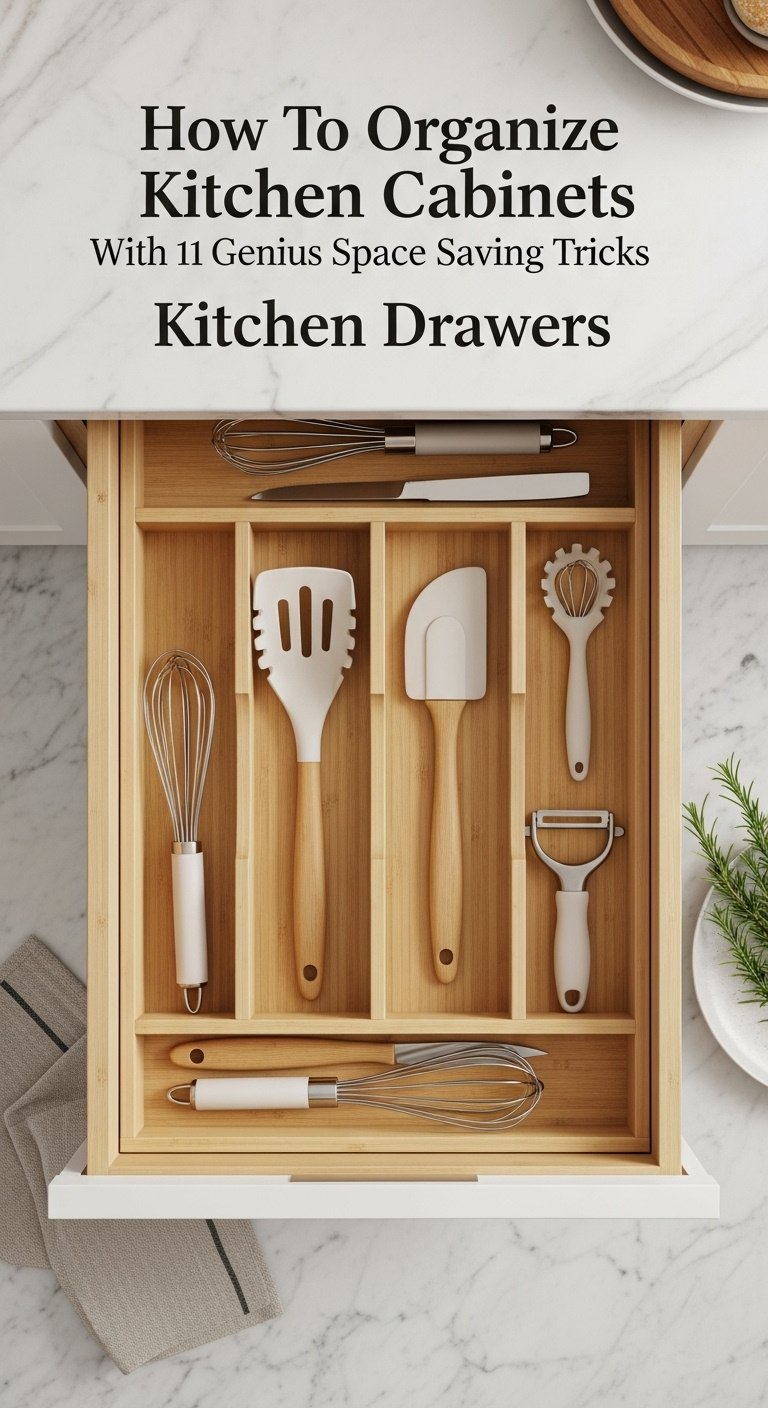
Drawer dividers stop the jumble of utensils and gadgets and create a neat, accessible system where everything has a home.
- Materials Needed: Measuring tape, drawer dividers or inserts.
- Step-by-Step Directions:
- Empty and clean the drawer.
- Measure the interior dimensions of the drawer.
- Purchase dividers that fit. For ultimate customization, choose adjustable spring-loaded bamboo dividers. For cutlery, select a tray with appropriately sized compartments.
- Insert the dividers, creating a specific home for each type of utensil or gadget.
- Group like items together in their new compartments.
Pro-Tip: For deep drawers storing food containers, use adjustable dividers to create lanes for containers and a separate section for all the lids. This is the ultimate fix for container avalanches.
Tag someone whose drawers need this transformation! #organizationgoals
7. Tame Your Tupperware with a Lid Organizer

A lid organizer is the permanent solution to the frustrating problem of mismatched food containers and messy, overflowing lids.
- Materials Needed: A dedicated lid organizer (like a small file rack or adjustable bin), all your food containers and lids.
- Step-by-Step Directions:
- Gather all your food storage containers and lids. Match them up and discard any containers without a matching lid, and vice versa.
- Nest the container bases together by size and shape (squares with squares, etc.) and place them in your cabinet or drawer.
- Place the lid organizer next to the stacked containers.
- File the lids vertically in the organizer, sorted by size or shape.
Pro-Tip: Consider switching to a single set of glass containers. They nest perfectly, don’t stain or retain odors, and since they are all from one set, the lids are often interchangeable and easier to manage.
Ready to end the container chaos? Pin this now!
8. Decant Dry Goods into Clear, Labeled Containers
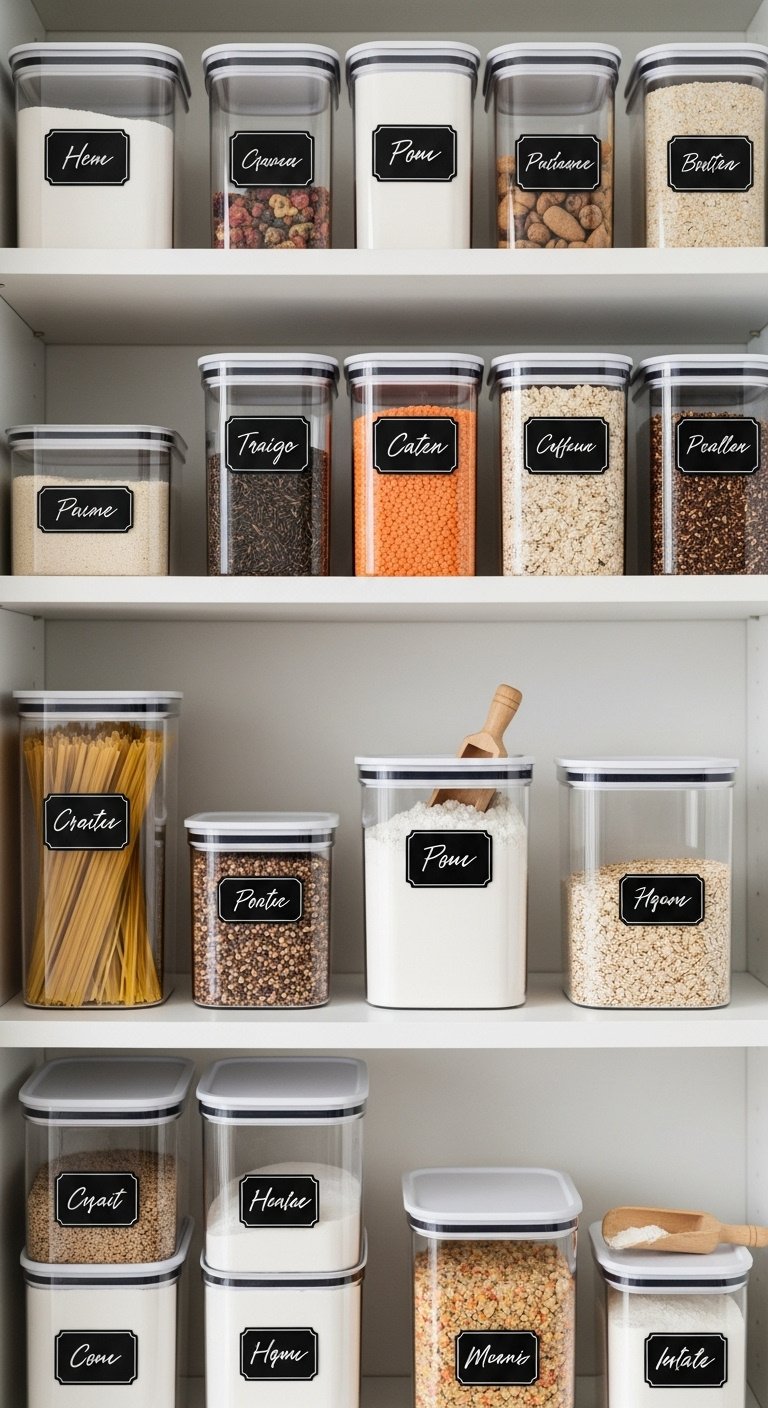
Decanting creates a visually appealing pantry system that keeps food fresh longer and makes it easy to see your inventory at a glance.
- Materials Needed: Airtight clear containers, labels, marking pen or chalk.
- Step-by-Step Directions:
- Choose uniform containers that are stackable and fit your cabinet space.
- Decant dry goods like pasta, grains, and snacks from their bulky original packaging into the clear containers.
- Create clear, consistent labels for each container. Include the item name and, if desired, the expiration date.
- Arrange the containers on your shelves. For deep shelves, place taller items in the back.
Lesson Learned: Square or rectangular containers are more space-efficient than round ones because they fit together without any gaps. This maximizes every inch of your shelf space.
Pin this pantry inspiration to your ‘Dream Home’ board!
9. Install a Magnetic Strip for Knives and Spices
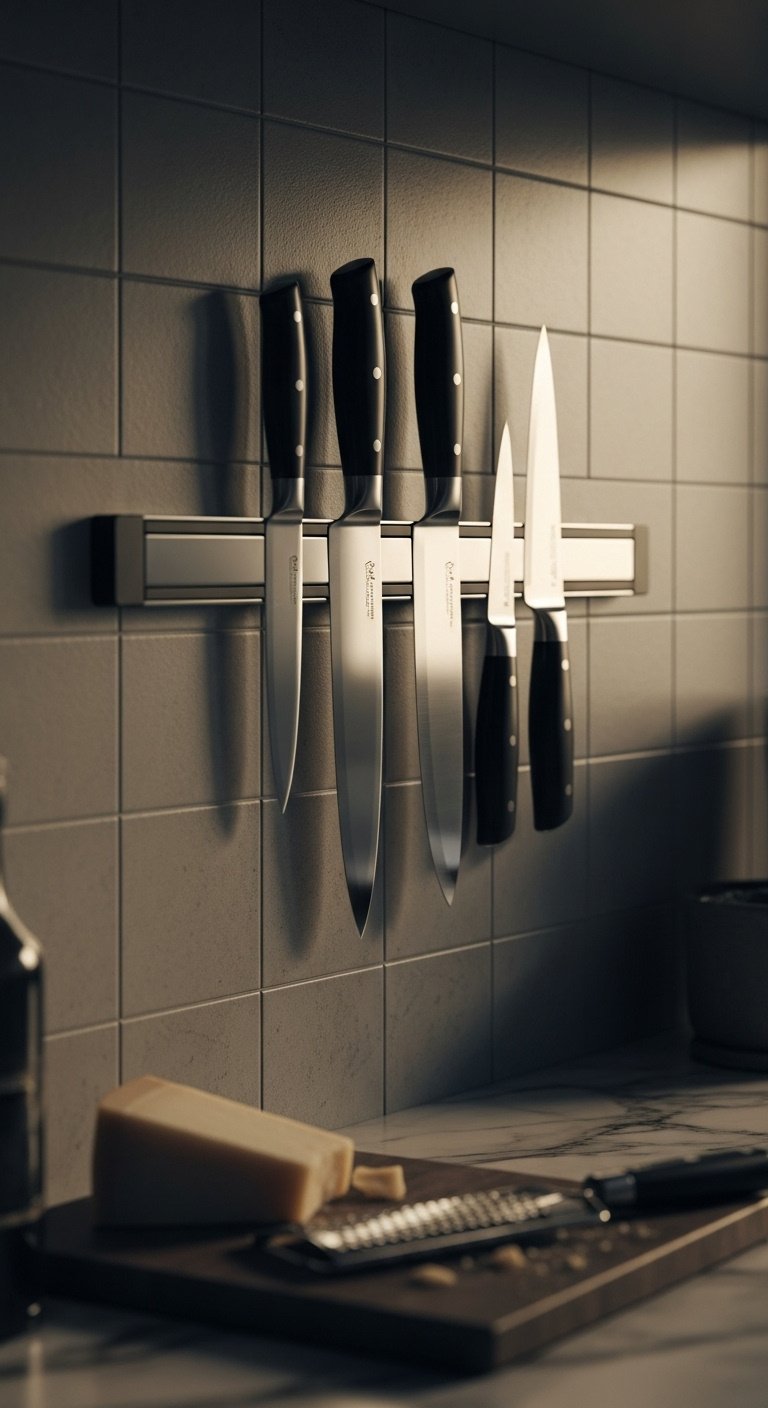
A magnetic strip helps free up valuable counter and drawer space by utilizing vertical wall space for storing knives or spices.
- Materials Needed: Magnetic strip, drill, screws, level, pencil.
- Step-by-Step Directions:
- Identify a suitable location: on the backsplash, on the side of a cabinet, or inside a cabinet door.
- Hold the magnetic strip against the wall and use a level to ensure it’s straight.
- Use a pencil to mark where the screws will go.
- Drill pilot holes and then securely mount the strip to the wall with screws.
- Carefully place your knives on the strip, or attach magnets to your spice jars/use magnetic tins.
Pro-Tip: Ensure you purchase a strip with a strong magnet, especially for heavy chef’s knives. Test the strength before you fully release the knife to ensure it’s securely held.
A chef-worthy trick for any kitchen! Save this to your ‘Kitchen Gadgets’ board.
10. Maximize the Awkward Space Under the Sink
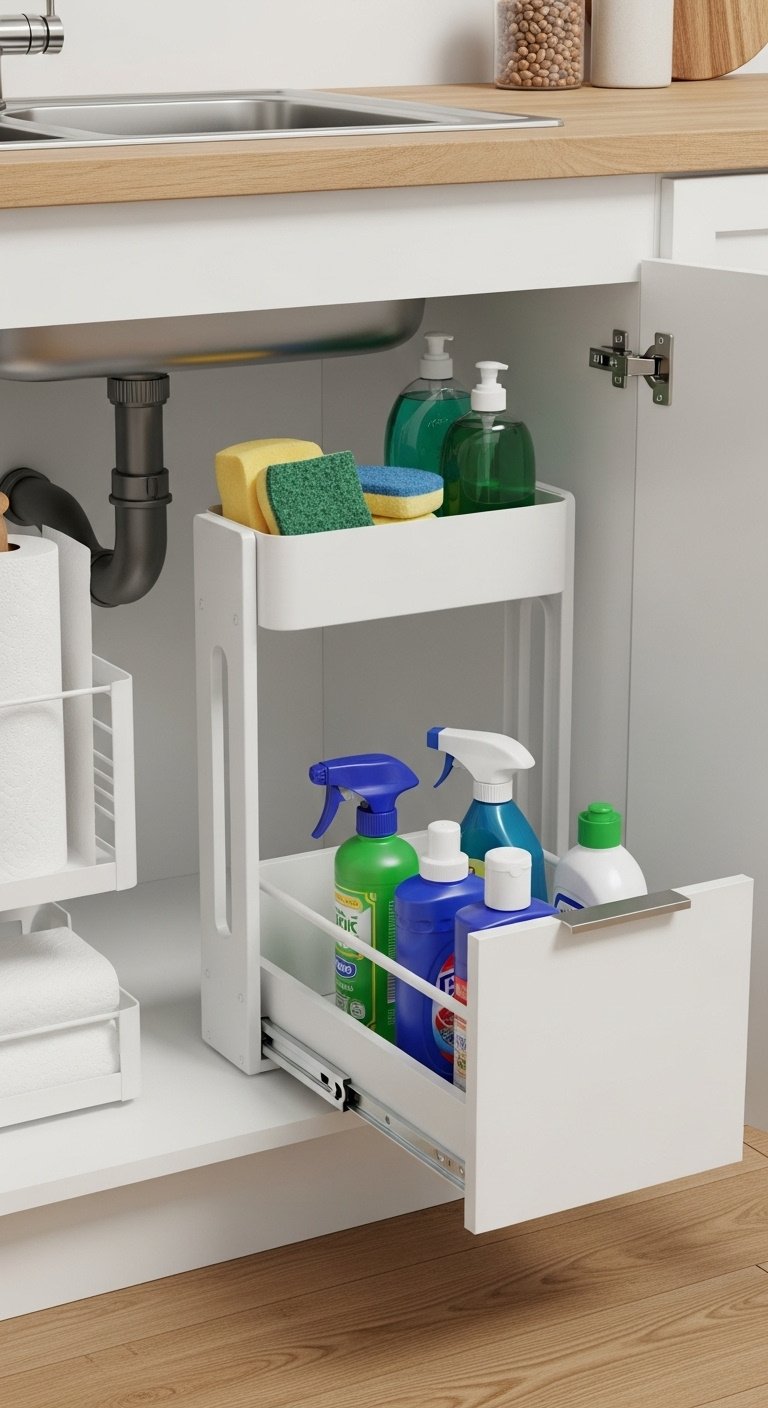
Specialized organizers help you efficiently organize the awkward cabinet space around plumbing pipes and create a functional spot for cleaning supplies.
- Materials Needed: Measuring tape, 2-tier sliding organizer designed for under sinks, or stackable bins.
- Step-by-Step Directions:
- Empty and thoroughly clean the cabinet under your sink.
- Measure the usable space on either side of the plumbing and garbage disposal.
- Purchase an organizer designed to fit around pipes. Many have a narrow top tier and a wider bottom tier. Alternatively, use stackable clear bins.
- Assemble and place the organizer in the cabinet.
- Arrange your cleaning supplies, with frequently used items in the front or on the top tier.
Pro-Tip: Place a waterproof liner on the bottom of the cabinet before you start organizing. This protects the wood from any potential leaks or drips from soap bottles.
Transform your under-sink chaos! Pin this idea for later.
11. Create a “Beverage Station” Cabinet

A beverage station helps streamline your morning routine by creating a single, dedicated cabinet for all coffee and tea supplies.
- Materials Needed: Shelf risers, small bins or baskets, hooks (optional).
- Step-by-Step Directions:
- Choose a cabinet located conveniently near your coffee maker and a water source.
- Use a shelf riser to create a second level for mugs, doubling your storage.
- Use small, clear bins to corral loose items like tea bags, sugar packets, or coffee pods.
- For extra space, install small adhesive hooks under the shelf to hang a few favorite mugs by their handles.
Lesson Learned: By containing everything in one spot, you not only make your mornings more efficient but also free up space in other cabinets that were holding stray mugs or boxes of tea.
Perfect for coffee lovers! Save this to your ‘Morning Routine’ board.
Key Takeaways: Your Quick Guide to a Perfectly Organized Kitchen
Feeling motivated? Here’s a quick summary of the core principles to remember as you tackle your kitchen cabinet organization project.
- Declutter First, Always: You can’t organize clutter. Start by removing everything and purging what you don’t need.
- Work with Zones: Store items where you use them. Group cooking, cleaning, and prep items to create an efficient workflow.
- Go Vertical: Most cabinets have wasted vertical space. Use shelf risers and vertical dividers to maximize every inch.
- Make Everything Accessible: Use turntables, pull-out shelves, and door organizers to ensure you can easily see and reach every single item.
- Contain & Label: Use clear containers, bins, and dividers to give every small item a home. Labeling is key to long-term success.
People Also Ask About Organizing Kitchen Cabinets
How do you decide where to put things in kitchen cabinets?
The best method is to create “zones” based on how you use your kitchen. Store items near where they are most frequently used. For example, keep pots, pans, and cooking oils near the stove. Place everyday dishes and glasses near the dishwasher for easy unloading. Keep food prep items like cutting boards and knives near your main stretch of counter space.
What are the 10 steps for organizing kitchen cabinets?
A thorough process includes: 1. Empty all cabinets. 2. Clean interiors. 3. Declutter and sort items. 4. Plan your zones. 5. Measure your space. 6. Purchase organizers. 7. Group like items. 8. Arrange items in their zones, placing frequently used items at the front. 9. Label containers. 10. Schedule regular, quick tidy-ups to maintain the system.
How to organize kitchen cabinets efficiently?
Efficiency comes from maximizing accessibility and visibility. Use clear containers for pantry goods, install pull-out drawers for deep cabinets, and use turntables in corner cabinets. The goal is to be able to see and reach what you need without having to move five other things out of the way first. Storing items vertically is often more efficient than stacking them horizontally.
What is the best way to organize dishes in kitchen cabinets?
The best way is to use a shelf riser to create a second level within the cabinet. This allows you to stack dinner plates below and salad plates or bowls on top, avoiding tall, unstable stacks. Store less-frequently used serving dishes on higher shelves. For deep cabinets or drawers, a pegboard-style organizer can hold dishes securely and make them easy to access.
Final Thoughts
Organizing your kitchen cabinets isn’t about achieving a picture-perfect space overnight. It’s about creating a system that reduces daily friction and makes your life easier. By embracing the principles of decluttering, zoning, and using smart storage solutions, you can transform your kitchen from a source of stress into a space of function and calm. Start with one cabinet, implement just one of these tricks, and see what a huge impact it can make.
Which of these kitchen cabinet tricks are you most excited to try first? Let us know in the comments below
